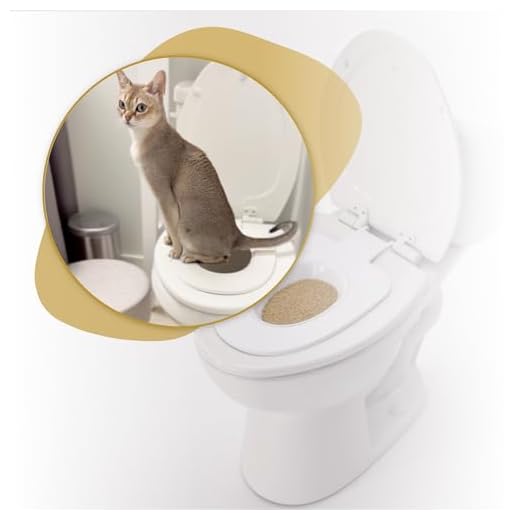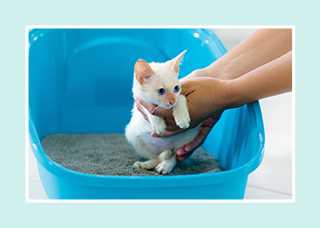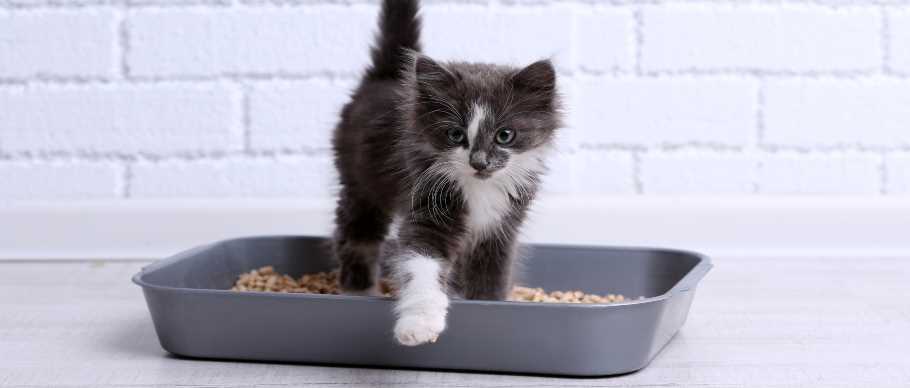



Begin with a specially designed training box that mimics the feel of a natural setting. Choose one that is open and has a low entry point, allowing easy access for your furry friend. This initial step is crucial for making the experience feel comfortable and familiar.
Incorporate clumping material that absorbs odors, as this will entice your companion to use the designated area more frequently. Place a small amount of this substance in the box to encourage exploration. Cats are naturally curious, so the right scent can prompt them to investigate further.
Consistency is key; maintain a routine for visits to the box. After meals and playtime, gently place your furry companion in the designated spot. Use positive reinforcement, such as gentle praise or treats, to create a positive association with the experience. This will help build a habit over time.
Monitor your companion’s behavior. If they show signs of reluctance, reassess the location of the box and the materials used. Sometimes, a simple change can make a world of difference. Patience and understanding are your best allies in this process.
Lastly, keep the area clean. Regularly scoop out waste and refresh the materials to ensure a pleasant environment. A clean space will encourage your furry friend to return, reinforcing their new habits. With time and effort, success is just around the corner!
Setting Up the Perfect Spot
Choose a quiet, low-traffic area for the box. Privacy matters, so avoid placing it near noisy appliances or in busy hallways. A calm environment encourages me to use it consistently.
Choosing the Right Box and Material
Select a box with low sides for easy access. I appreciate a litter type that mimics natural soil; clay or clumping varieties are usually preferred. Avoid overly scented options, as they can be off-putting.
Establishing Routine
Consistency is key. Place me near the box after meals or naps, as these are times I often need to relieve myself. Regularly checking for signs of discomfort can help ensure I feel secure using the box.
Positive Reinforcement

Every time I use the box, offer treats or affection. Positive experiences build confidence in using the designated area. Avoid punishment; it creates anxiety, making me less likely to return.
Regular Maintenance
Keep the box clean by scooping daily and changing litter weekly. A clean environment keeps me content and encourages regular use. If I notice odors or messes, I might hesitate to go back.
Monitoring Behavior
Watch for any changes in my habits. If I stop using the box or seem distressed, consult a vet to rule out medical issues. Understanding my needs ensures a happy and healthy lifestyle.
Choosing the Right Litter and Box for Your Feline Friend
Selecting the appropriate substrate and container is key for a smooth transition. Opt for a box that is spacious enough for comfortable movement; a larger size often accommodates various postures. Aim for a height that allows easy access, especially for older or less mobile companions.
Types of Litter

Consider different types of substrates. Clumping clay options provide easy cleanup, while natural alternatives like corn or wheat can be more eco-friendly. Experiment with types to see what your furry pal prefers. Avoid overly perfumed litters, as they may deter usage.
Location Matters
Place the box in a quiet, low-traffic area. Cats seek privacy, so a secluded spot can help encourage use. Ensure the space is easily accessible, avoiding clutter or obstacles that may discourage visits. Check the box regularly for cleanliness; a dirty environment may lead to avoidance.
If your companion shows signs of discomfort or changes in habits, consider exploring how to treat a cat urinary tract infection at home.
Establishing a Consistent Routine for Litter Training
To create a successful schedule, I recommend setting specific times for bathroom breaks. Morning and evening are ideal, as I’m more likely to follow a routine then. Consistency helps me understand when it’s time to use the box.
Monitoring Behavior
Pay attention to my behavior. If I start sniffing around or scratching at the floor, it’s a signal that I need to go. By observing these cues regularly, you can reinforce the routine further.
Positive Reinforcement
Whenever I use the designated area, reward me with treats or praise. This reinforces the habit and makes me more likely to repeat the behavior. Keeping these rewards consistent will strengthen my understanding of the routine.
Addressing Common Challenges During Litter Training
Accidents happen, and it’s important to remain calm. Here are some strategies to tackle frequent issues:
-
Refusal to Use the Box:
If I ignore the box, check the type of substrate. Some prefer finer textures over coarse ones. Experiment with different options until you find the right fit.
-
Box Location:
Ensure the box is in a quiet, low-traffic area. If it’s too exposed, I might feel stressed and avoid it.
-
Inappropriate Elimination:
Marking territory can be an issue. If I start choosing odd spots, consult a vet to rule out medical concerns. Stress or changes in the home can also trigger this behavior.
-
Inconsistent Usage:
To develop a habit, maintain a consistent schedule. Regular feeding times lead to predictable bathroom breaks.
-
Box Cleanliness:
Keep the box tidy. I tend to avoid dirty areas. Scoop daily and change the litter regularly to encourage usage.
Address each challenge with patience. Every effort counts toward building a comfortable routine for me.
Video:
Begin with a specially designed training box that mimics the feel of a natural setting. Choose one that is open and has a low entry point, allowing easy access for your furry friend. This initial step is crucial for making the experience feel comfortable and familiar.
Incorporate clumping material that absorbs odors, as this will entice your companion to use the designated area more frequently. Place a small amount of this substance in the box to encourage exploration. Cats are naturally curious, so the right scent can prompt them to investigate further.
Consistency is key; maintain a routine for visits to the box. After meals and playtime, gently place your furry companion in the designated spot. Use positive reinforcement, such as gentle praise or treats, to create a positive association with the experience. This will help build a habit over time.
Monitor your companion’s behavior. If they show signs of reluctance, reassess the location of the box and the materials used. Sometimes, a simple change can make a world of difference. Patience and understanding are your best allies in this process.
Lastly, keep the area clean. Regularly scoop out waste and refresh the materials to ensure a pleasant environment. A clean space will encourage your furry friend to return, reinforcing their new habits. With time and effort, success is just around the corner!
Setting Up the Perfect Spot
Choose a quiet, low-traffic area for the box. Privacy matters, so avoid placing it near noisy appliances or in busy hallways. A calm environment encourages me to use it consistently.
Choosing the Right Box and Material
Select a box with low sides for easy access. I appreciate a litter type that mimics natural soil; clay or clumping varieties are usually preferred. Avoid overly scented options, as they can be off-putting.
Establishing Routine
Consistency is key. Place me near the box after meals or naps, as these are times I often need to relieve myself. Regularly checking for signs of discomfort can help ensure I feel secure using the box.
Positive Reinforcement

Every time I use the box, offer treats or affection. Positive experiences build confidence in using the designated area. Avoid punishment; it creates anxiety, making me less likely to return.
Regular Maintenance
Keep the box clean by scooping daily and changing litter weekly. A clean environment keeps me content and encourages regular use. If I notice odors or messes, I might hesitate to go back.
Monitoring Behavior
Watch for any changes in my habits. If I stop using the box or seem distressed, consult a vet to rule out medical issues. Understanding my needs ensures a happy and healthy lifestyle.
Choosing the Right Litter and Box for Your Feline Friend
Selecting the appropriate substrate and container is key for a smooth transition. Opt for a box that is spacious enough for comfortable movement; a larger size often accommodates various postures. Aim for a height that allows easy access, especially for older or less mobile companions.
Types of Litter

Consider different types of substrates. Clumping clay options provide easy cleanup, while natural alternatives like corn or wheat can be more eco-friendly. Experiment with types to see what your furry pal prefers. Avoid overly perfumed litters, as they may deter usage.
Location Matters
Place the box in a quiet, low-traffic area. Cats seek privacy, so a secluded spot can help encourage use. Ensure the space is easily accessible, avoiding clutter or obstacles that may discourage visits. Check the box regularly for cleanliness; a dirty environment may lead to avoidance.
If your companion shows signs of discomfort or changes in habits, consider exploring how to treat a cat urinary tract infection at home.
Establishing a Consistent Routine for Litter Training
To create a successful schedule, I recommend setting specific times for bathroom breaks. Morning and evening are ideal, as I’m more likely to follow a routine then. Consistency helps me understand when it’s time to use the box.
Monitoring Behavior
Pay attention to my behavior. If I start sniffing around or scratching at the floor, it’s a signal that I need to go. By observing these cues regularly, you can reinforce the routine further.
Positive Reinforcement
Whenever I use the designated area, reward me with treats or praise. This reinforces the habit and makes me more likely to repeat the behavior. Keeping these rewards consistent will strengthen my understanding of the routine.
Addressing Common Challenges During Litter Training
Accidents happen, and it’s important to remain calm. Here are some strategies to tackle frequent issues:
-
Refusal to Use the Box:
If I ignore the box, check the type of substrate. Some prefer finer textures over coarse ones. Experiment with different options until you find the right fit.
-
Box Location:
Ensure the box is in a quiet, low-traffic area. If it’s too exposed, I might feel stressed and avoid it.
-
Inappropriate Elimination:
Marking territory can be an issue. If I start choosing odd spots, consult a vet to rule out medical concerns. Stress or changes in the home can also trigger this behavior.
-
Inconsistent Usage:
To develop a habit, maintain a consistent schedule. Regular feeding times lead to predictable bathroom breaks.
-
Box Cleanliness:
Keep the box tidy. I tend to avoid dirty areas. Scoop daily and change the litter regularly to encourage usage.
Address each challenge with patience. Every effort counts toward building a comfortable routine for me.
Video:
Begin with a specially designed training box that mimics the feel of a natural setting. Choose one that is open and has a low entry point, allowing easy access for your furry friend. This initial step is crucial for making the experience feel comfortable and familiar.
Incorporate clumping material that absorbs odors, as this will entice your companion to use the designated area more frequently. Place a small amount of this substance in the box to encourage exploration. Cats are naturally curious, so the right scent can prompt them to investigate further.
Consistency is key; maintain a routine for visits to the box. After meals and playtime, gently place your furry companion in the designated spot. Use positive reinforcement, such as gentle praise or treats, to create a positive association with the experience. This will help build a habit over time.
Monitor your companion’s behavior. If they show signs of reluctance, reassess the location of the box and the materials used. Sometimes, a simple change can make a world of difference. Patience and understanding are your best allies in this process.
Lastly, keep the area clean. Regularly scoop out waste and refresh the materials to ensure a pleasant environment. A clean space will encourage your furry friend to return, reinforcing their new habits. With time and effort, success is just around the corner!
Setting Up the Perfect Spot
Choose a quiet, low-traffic area for the box. Privacy matters, so avoid placing it near noisy appliances or in busy hallways. A calm environment encourages me to use it consistently.
Choosing the Right Box and Material
Select a box with low sides for easy access. I appreciate a litter type that mimics natural soil; clay or clumping varieties are usually preferred. Avoid overly scented options, as they can be off-putting.
Establishing Routine
Consistency is key. Place me near the box after meals or naps, as these are times I often need to relieve myself. Regularly checking for signs of discomfort can help ensure I feel secure using the box.
Positive Reinforcement

Every time I use the box, offer treats or affection. Positive experiences build confidence in using the designated area. Avoid punishment; it creates anxiety, making me less likely to return.
Regular Maintenance
Keep the box clean by scooping daily and changing litter weekly. A clean environment keeps me content and encourages regular use. If I notice odors or messes, I might hesitate to go back.
Monitoring Behavior
Watch for any changes in my habits. If I stop using the box or seem distressed, consult a vet to rule out medical issues. Understanding my needs ensures a happy and healthy lifestyle.
Choosing the Right Litter and Box for Your Feline Friend
Selecting the appropriate substrate and container is key for a smooth transition. Opt for a box that is spacious enough for comfortable movement; a larger size often accommodates various postures. Aim for a height that allows easy access, especially for older or less mobile companions.
Types of Litter

Consider different types of substrates. Clumping clay options provide easy cleanup, while natural alternatives like corn or wheat can be more eco-friendly. Experiment with types to see what your furry pal prefers. Avoid overly perfumed litters, as they may deter usage.
Location Matters
Place the box in a quiet, low-traffic area. Cats seek privacy, so a secluded spot can help encourage use. Ensure the space is easily accessible, avoiding clutter or obstacles that may discourage visits. Check the box regularly for cleanliness; a dirty environment may lead to avoidance.
If your companion shows signs of discomfort or changes in habits, consider exploring how to treat a cat urinary tract infection at home.
Establishing a Consistent Routine for Litter Training
To create a successful schedule, I recommend setting specific times for bathroom breaks. Morning and evening are ideal, as I’m more likely to follow a routine then. Consistency helps me understand when it’s time to use the box.
Monitoring Behavior
Pay attention to my behavior. If I start sniffing around or scratching at the floor, it’s a signal that I need to go. By observing these cues regularly, you can reinforce the routine further.
Positive Reinforcement
Whenever I use the designated area, reward me with treats or praise. This reinforces the habit and makes me more likely to repeat the behavior. Keeping these rewards consistent will strengthen my understanding of the routine.
Addressing Common Challenges During Litter Training
Accidents happen, and it’s important to remain calm. Here are some strategies to tackle frequent issues:
-
Refusal to Use the Box:
If I ignore the box, check the type of substrate. Some prefer finer textures over coarse ones. Experiment with different options until you find the right fit.
-
Box Location:
Ensure the box is in a quiet, low-traffic area. If it’s too exposed, I might feel stressed and avoid it.
-
Inappropriate Elimination:
Marking territory can be an issue. If I start choosing odd spots, consult a vet to rule out medical concerns. Stress or changes in the home can also trigger this behavior.
-
Inconsistent Usage:
To develop a habit, maintain a consistent schedule. Regular feeding times lead to predictable bathroom breaks.
-
Box Cleanliness:
Keep the box tidy. I tend to avoid dirty areas. Scoop daily and change the litter regularly to encourage usage.
Address each challenge with patience. Every effort counts toward building a comfortable routine for me.










